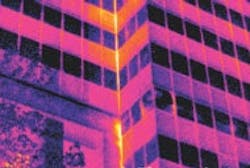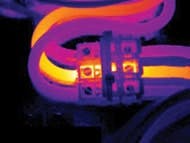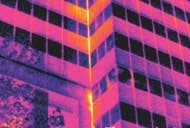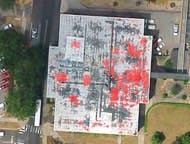Increase Your Infrared-Technology IQ
You’ve received three complaints this month about a leaking roof, but you aren’t convinced about what’s happening (or if the leak is even coming from the roof in the first place). It’s an older roofing system, but it’s still under warranty; you’ve called in the contractor to take a look (they say you need a complete tear-off), but you’re still not sure. What do you do? You can’t just make an educated guess to determine the fate of a million-dollar asset, can you? Or, maybe it’s not the roof you’re worried about - it’s the incoming electrical service, the mechanical equipment, or the exterior windows and doors.
At some point, the operation of these building systems will hinge on a decision (or two or three) made about their performance, maintenance, and efficiency. If an incorrect assessment is made, it can ravage time, materials, and money. The good news? You’re not alone in making these evaluations - infrared technology can serve as your aid.
The use of infrared imaging isn’t a new concept (its use in commercial facilities began in the 1960s), but improvements to this technology have made it a workable option for inspecting and diagnosing conditions in many situations. What was once detectable only through destructive investigation can now be uncovered without disturbing a thing. “Infrared is almost like an X-ray machine for buildings,” says Valerie Patterson, president at Orlando, FL-based Infrared Concepts Corp. (Infrared Concepts specializes in building-envelope studies.) The non-contact, non-destructive technology allows you to “view” a variety of interior and exterior building systems, detects heat and accurately measures temperature differences, and converts them into an electronic signal. It’s then processed to produce a thermal image on a video monitor and perform temperature calculations.
Unlike video cameras, which convert visible light into electronic images, infrared cameras create electronic images based upon heat emissions (which are undetectable in normal viewing conditions). “An infrared camera works in a very similar way to today’s digital video cameras that use lenses to gather light and focus it on an image sensor - it’s just that the infrared camera’s imaging sensor responds to a different wavelength of light,” says Art Stout, vice president of business development, Fairfield, NJ-based Electrophysics. “Infrared imaging can show you something about the condition of whatever it is that you’re looking at.” A professionally generated report with thermal images, moisture samples, and other data, can reveal moisture conditions, hot spots, possible defects, etc.
Got System-Performance Problems? Get Infrared.
According to Beachwood, OH-based Predictive Service Corp., nearly everything that uses or transmits power gets hot before it fails, which means that an infrared camera can detect failure before it leads to downtime, production loss, power outage, fire, or catastrophic failure. Take a look at what infrared technology can be used for ...
- Electrical panels and systems. Look for poor connections; corrosion; loose parts; electrical shorts; incoming power supply, power transformation to lower voltages, and power distribution; UPS and lighting performance; load imbalances; etc.
- Roofing systems. Look for leaks, wet insulation, ponding, etc.
- Windows/doors. Look for air infiltration/exfiltration, etc.
- Exterior walls. Look for delamination on walls, masonry, and foundation; insulation R-values; weatherization.
- Mechanical systems. Look at rotating parts; wear of motors, bearings, and belts; loose parts; insulation voids on chilled-water lines; escalator/elevator rails; plumbing leaks.
- Steam systems. Look at steam traps, insulation on steam lines.
If you think some of these applications seem trivial, think again: Infrared can make a difference no matter where it's used. Something as small as an escalator rail’s performance can have a major effect on overall building performance. “If one escalator rail is 4-degrees F. hotter than the other due to friction, big deal - right?” asks Ronald D. Lucier, infrared and thermal regional thermography course manager at Boston-based FLIR Systems Inc. “In a 2-story building, due to the size of the escalator, it can generate an extra 40 watts of heat - that’s 40 watts that the building owner has to pay for. Every hour, hour after hour, it’s running. In the big picture of a $500,000-per-month electrical bill, it really isn’t a big thing; over time, it adds up.”
The Great Thing(s) About Infrared
There are many benefits to incorporating infrared technology into your routine-maintenance schedule and using it as a tool to assess potential problems.
Obviously, it’s a cost-effective way to investigate the inner workings of a building or a piece of equipment without having to actually tear anything apart. “You can scientifically determine the true condition of a building envelope or piece of equipment rather than taking a ‘best-guess’ approach,” says Patterson. Knowing the real reason behind why your roof is failing or your energy bill is suddenly $1,000 higher can help in reducing costs and conserving resources. If you decrease the unnecessary removal of quality materials (which commonly occurs during the process of guessing what’s wrong with a system) and base your actions upon tangible information, you’ll cut back on time spent searching for leaks, loose connections, shorts, etc.
Preventive-maintenance processes are also improved with the use of infrared. If you have a tool that tells you how your systems are performing, it keeps your team from functioning in “reaction” mode and improves your chances of being able to resolve an issue before it gets out of hand. You can also use the information from an infrared study to gauge how each system is faring from year to year (by tracking moisture progression, for example).
The technology can serve as legal evidence to validate claims for remediation reimbursement as a result of a construction error. “It’s a way to hold contractors accountable for their work,” says Patterson. Texas plans to include infrared studies as part of the state’s contract documents for new roofs. If the new roof turns out to be in perfect condition after the study, the contractor has effectively completed the project and the building owner can view the infrared study as a precautionary measure. However, if the infrared study uncovers a mistake, these documents will require contractors to fix the error and reimburse the client for the infrared study.
It may also serve as legal evidence in case of a natural disaster (such as a hurricane). “Some infrared services are reimbursable for pre- and post-hurricane damage. If you want to get FEMA dollars or you want to secure insurance reimbursement, you need to know what the status of your building was before the hurricane so that FEMA can’t say, ‘Your building was probably compromised before that hurricane ever came along,’ ” explains Patterson.
Infrared technology can come into play for insurance purposes, too. When insurance companies set their rates for a facility or portfolio, Lucier says that some take into consideration whether or not a building owner has an established infrared program in place. If he/she does, it helps the organization achieve a better rate.
In terms of capital and operations planning/budgeting, infrared studies can provide a means of prioritizing needed repairs and replacements. In real time, you can inspect equipment and systems, and rearrange the purchases and investments based upon the results of the study. As Patterson points out, infrared provides a short-term and long-term guide as to where to allocate dollars when you’re confident about the condition of your assets. The results from an infrared study can also be used to help secure the required funds for a capital purchase or convince upper-level management of an investment that needs to be made.
Risk reduction is another benefit of using the technology. “Knowing that a motor is in the early stages of overheating allows maintenance to plan for its replacement under normal repair procedures [and reduce risk]. Ignoring [the inspection of] a motor may lead to it overheating, filling certain areas with smoke, causing a small fire which disrupts the occupants, etc.,” says Lucier. “There is a simple equation for risk: the probability that something will happen multiplied by the consequences. Using infrared and acting on the results from an inspection reduces risk,” he points out.
Most experts agree that infrared can be cost effective in virtually any structure. “Success is the direct result of 1) good cameras, 2) well-trained and motivated infrared inspectors, and, most importantly, 3) an invested management,” says Lucier. Patterson adds that a final, easy-to-read infrared report displaying the findings of the study is also essential.
What Infrared Can’t Do
“Infrared has its kryptonite,” says Patterson. “It can’t see through metal, barrel tile (or tile of any kind), or shingles that are in a pitch. In roofing applications, it’s really designed for a traditional, commercial flat roof or a low-slope roof that doesn’t exceed a 2/12 pitch.” Infrared cameras can’t see through foamed-over roofing systems or other highly reflective surfaces, either.
The bottom line regarding what infrared can and can’t be used for: “The materials composing the roof and walls will determine if infrared technology can be used to inspect the building,” says Patterson.
Which is Better: A Hand-Held Camera or Third-Party Consultant?
In addition to deciding where and how to use infrared technology, you’ll also have to settle on whether to use a do-it-yourself, hand-held infrared camera or to call in a certified, third-party consultant. You can make this determination based upon a number of factors, including:
The number of days you plan to apply the technology. “If the answer is 2 or 3 days, you really wouldn’t benefit from owning a piece of equipment,” says Stout. “Unless you’re planning to use it 15 to 20 days a year, you’re better off hiring a consultant.” However, he also emphasizes that some real estate organizations may want or need access to inspection results right away; those situations need to be considered separately.
The in-house staff available to learn the technology (and management’s willingness to spend money on training). Some facilities management teams - especially those with a limited number of employees - prefer to keep staff members dedicated to high-priority tasks. If your department doesn’t have the time to devote to grasping the ins and outs of the equipment, it may not be cost effective to invest in a hand-held camera.
The ability to back up your purchase with the creation of an infrared program. “It’s like any other tool,” says Stout. “If it’s not going to be used in a coordinated fashion and is just going to sit on the shelf without being used, the benefits of owning it will never be realized. Users have to be trained, best practices have to be established, and a programmatic approach toward infrared must be established.”
The urgency of infrared applications. As Lucier points out, certified specialists offer experience in using the cameras every day, but may not always be available when needed. Chances are, you’ll get better quality through a third-party contractor, but you’ll lose the convenience of having equipment on hand.
The size of your infrared projects. “A third party can perform infrared imaging on a larger scale; for example, they may have the capability of capturing images of the entire roof as well as multiple images of specific areas to create composite reports that are complete and detailed,” says Patterson.
If You’re Investing in a Hand-Held Camera ...
Stout advises that purchasing a hand-held infrared camera is the same as buying any tool. “It’s about how easy it is to use, ergonomics (comfort for the operator), and how instinctive it is to operate. Unless you’re a big real estate management company and are going to hire somebody full time, these cameras aren’t going to be used that much - so they need to be intuitive.”
Automation features and other innovations (detector technology, built-in visual imaging, and software developments) can reduce do-it-yourself errors, but beware of the “anybody-can-use-these-cameras-without-any-training” phrase; it’s just not true.
Cameras are becoming easier to operate and less expensive. When choosing equipment, carefully evaluate and understand the cost of ownership. “When you can justify the purchase and do a good job with the equipment, then you should be a buyer,” says Stout. “If the cameras are used, and the facilities are large enough for them to be used productively and as they were designed, the return on investment is always going to be there.”
Remember why you’re purchasing the camera in the first place and what it can be used for. “We have made these cameras so easy to use that there are an increasing number of people making errors in the industry; they are exceeding their own level of competence and trying to extend [infrared technology] into what it cannot do,” says Lucier.
Don’t make the mistake of thinking that infrared is an easy discipline to master. As Stout points out, if a facilities professional is going to use a hand-held camera, he/she needs to learn what to look for. “There are things that should be warm; an electrician will be able to diagnose and see things in electrical circuits that, if it were given to someone who wasn’t an electrician, wouldn’t be understood.”
If You’re Investing in a Third-Party Consultant ...
Do your research and ask for client references, how long the organization has been in business, what kind of clients they regularly work with, and what their image-analysis experience is. “It’s about the camera, whether the people operating the camera are certified, the longevity and credibility of the business, and the analysis of the image,” says Patterson. “Without an analysis and a printed report, it’s like a doctor saying, ‘Here’s your X-ray; figure out if you have a problem or not.’ ”
Make sure your third-party consultant has a minimum of 10 years’ experience in conducting infrared surveys nationwide, a minimum of 8 years of commercial experience, and liability insurance. Infrared experts specializing in roofing should survey at least 5 million square feet of roofing each year. Electrical-systems specialists must be able to work in step with electrical engineers. Specialists should be Level-2 Certified through a nationally known training company (such as the Burlington, NJ-based Infraspection Institute).
“An ideal infrared program incorporates the proper mix of both: an annual inspection by a certified specialist and follow-up and continuing diagnosis by an in-house person,” says Lucier.
Leah B. Garris ([email protected]) is senior associate editor at Buildings magazine.



